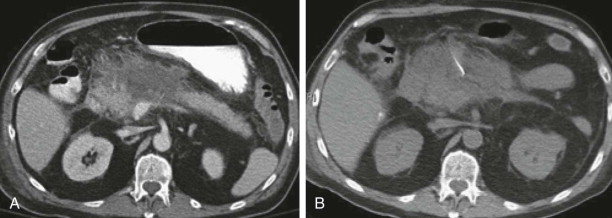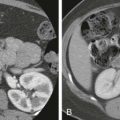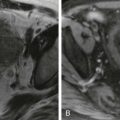Chapter Outline
Role of Interventional Radiology in the Management of Pancreatic Neoplasms
Role of Interventional Radiology in the Management of Acute Necrotizing Pancreatitis
Image-Guided Catheter Drainage: Technique
Management of Sterile Pancreatic Necrosis
Management of Infected Pancreatic Necrosis
Role of Interventional Radiology in the Management of Pancreatic Pseudocysts
Historically, percutaneous biopsy has played only a limited role in the evaluation and management of pancreatic masses. In the past, percutaneous biopsy was reserved mostly for tissue confirmation in tumors that appeared unresectable at the time of diagnosis, for diagnosis of lymphoma or metastatic disease (in which surgery typically would be unnecessary), and for differentiation of inflammatory pseudotumors from true pancreatic neoplasms. In recent years, however, advanced multidetector computed tomography (MDCT) and magnetic resonance imaging (MRI) techniques have improved the detection of cystic pancreatic neoplasms, and as a result, the role of percutaneous pancreatic mass biopsy has steadily increased.
Similarly, although the mainstay for treatment of patients with acute necrotizing pancreatitis has traditionally been surgical débridement, percutaneous image-guided catheter drainage has been proposed as a safe and alternative treatment option. Many patients with pancreatic necrosis undergo fine-needle aspiration to differentiate between infected and sterile pancreatic necrosis and, if deemed necessary to control systemic toxicity, percutaneous image-guided catheter drainage of pancreatic necrosis.
In this chapter, we review the specific clinical indications for pancreatic mass biopsy, summarize the reported diagnostic efficacy of percutaneous pancreatic mass biopsy, discuss the technical factors that contribute to results and failures, and highlight the possible limitations and complications of this procedure. Finally, we emphasize the current status of therapeutic radiology in patients with complicated pancreatitis so that the practicing radiologist can understand the current role of percutaneous image-guided aspiration and catheter drainage in the diagnosis and management of patients with necrotizing pancreatitis and pancreatic pseudocysts.
Role of Interventional Radiology in the Management of Pancreatic Neoplasms
Background
Pancreatic ductal adenocarcinoma, accounting for approximately 85% of all pancreatic neoplasms, is the fourth leading cause of cancer-related deaths in the United States; approximately 28,000 new cases of pancreatic cancer are diagnosed each year. Percutaneous biopsy is performed typically to diagnose the cause of a pancreatic mass identified by CT scan, MRI, or sonography. Biopsy is useful both to diagnose malignant disease and to determine the type of malignant neoplasm. For example, among malignant pancreatic tumors, including ductal adenocarcinomas, islet cell carcinomas, and lymphomas, each carries a different prognosis and is treated differently.
Percutaneous image-guided biopsy is an established means of diagnosing the cause of pancreatic masses. The procedure may be performed on an outpatient basis, and complication rates are low, ranging from 3% to 6.7%. A diagnostic rate of 97.7% was recently reported for CT-guided fine-needle aspiration biopsy of pancreatic masses. Endoscopic sonography–guided fine-needle aspiration biopsy is an increasingly used alternative technique for pancreatic mass biopsy.
Indications for Pancreatic Mass Biopsy
Patients with Imaging Findings That Suggest Unresectable Pancreatic Cancer
Percutaneous pancreatic mass biopsy is mainly indicated in patients with no known malignant neoplasm but whose imaging findings suggest an unresectable pancreatic tumor. In these patients, biopsy provides a tissue diagnosis that allows appropriate nonsurgical treatment to ensue ( Fig. 95-1 ). Important to realize is that in patients with unresectable pancreatic cancer and other extrapancreatic lesions, such as hepatic or peritoneal/omental masses, biopsy of the extrapancreatic mass could potentially result in less morbidity than biopsy of the pancreatic tumor. For example, in a patient presenting with both a pancreatic mass and a hepatic mass, if biopsy of the hepatic mass revealed a metastasis of pancreatic cancer, it would obviate subsequent biopsy of the pancreatic mass.
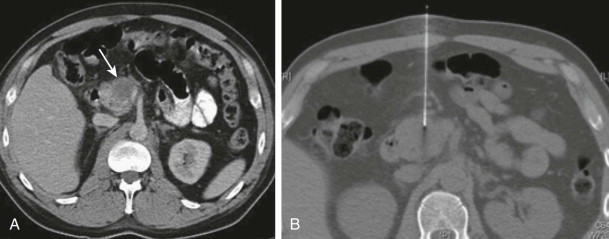
Patients with a Known Extrapancreatic Primary Cancer
Another indication for percutaneous biopsy of a pancreatic mass is in a patient with a pancreatic mass and a known extrapancreatic primary malignant neoplasm. Percutaneous pancreatic mass biopsy is indicated in these patients to differentiate a surgically resectable pancreatic ductal adenocarcinoma from a metastasis. A pretreatment diagnosis is needed because virtually all metastases are treated medically, whereas resectable pancreatic carcinomas are treated surgically. The importance of a pretreatment tissue diagnosis in these patients is especially emphasized in patients with lymphoma, renal cell carcinoma, and lung cancer, three tumors that spread not uncommonly to the pancreas. Therefore, when a pancreatic mass is detected in a patient with an extrapancreatic primary malignant neoplasm, the mass should not be presumed to represent a metastasis; biopsy should be performed ( Fig. 95-2 ).
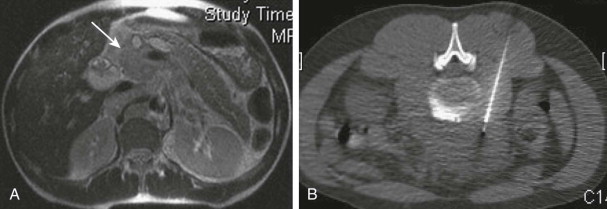
Patients with a Pancreatic Mass That May Be Caused by Inflammation
Chronic pancreatitis (including autoimmune and groove pancreatitis subtypes) can appear masslike and mimic a pancreatic neoplasm. Therefore, an inflammatory etiology should be considered to prevent a patient with a benign mass from going to surgery unnecessarily. Prior history and signs and symptoms of chronic pancreatitis are usually present. However, not infrequently, a pancreatic neoplasm with postobstructive pancreatitis induces overlapping symptoms. Therefore, if there is still the possibility of an inflammatory cause after a careful history and laboratory evaluation, percutaneous biopsy can be used to confirm the diagnosis of cancer or to identify an inflammatory cause.
Patients with a Cystic Pancreatic Mass
The precise role of percutaneous biopsy in the evaluation of cystic pancreatic masses is still controversial. In the past, the majority of these masses have been considered “surgical lesions” because, with the exception of the benign serous microcystic pancreatic adenoma, cystic neoplasms typically are malignant or have malignant potential (mucinous cystic tumors, intraductal papillary mucinous neoplasm, solid pseudopapillary tumor of the pancreas); they cannot be characterized confidently as benign on the basis of imaging alone, and they can be diagnosed as benign with certainty only if they are removed completely and examined fully at pathology. As a result, biopsy specimens obtained from the cyst’s wall or fluid typically contain only scant epithelial cells, inflammatory cells, and fibrous tissue, material that cannot be used to render a specific benign diagnosis. Retrieval of no malignant cells still leaves the interventional radiologist, referring physician, and patient with the possibility that the lesion was improperly sampled or missed.
Recently, helped by important advances in cyst fluid tumor marker analysis, immunohistochemistry, and molecular techniques, some authors have argued that percutaneous biopsy can be helpful in identifying patients with benign subtypes of cystic pancreatic masses, obviating surgery in these patients. Indeed, new advanced MDCT and MRI techniques have dramatically increased the detection of cystic pancreatic neoplasms, and although resection of all pancreatic cystic tumors would ensure that cancers are not missed, most small cystic pancreatic neoplasms grow slowly or not at all, and up to 87% of patients would undergo surgery unnecessarily. As a result, percutaneous biopsy may be advocated in selected circumstances, such as in symptomatic patients who have cystic pancreatic neoplasms smaller than 3 cm, patients who have comorbidities that increase the risk of surgical exploration, and patients with a cystic pancreatic mass diagnosed in the setting of acute or chronic pancreatitis ( Fig. 95-3 ). In these patients, biopsy results can simply serve as additional data that can be combined with imaging data to render a probable clinical diagnosis.
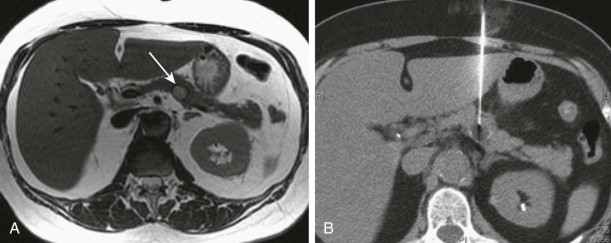
Multiple Solid Pancreatic Masses
As pancreatic ductal adenocarcinoma is solitary in more than 95% of cases, patients without a known primary malignant neoplasm who present with multiple, solid pancreatic masses are also good candidates for pancreatic biopsy. The differential diagnosis includes metastatic disease, but this is not likely if a primary tumor is not known. Primary lymphoma is another possibility, although lymphoma more commonly involves the pancreas secondarily, and associated lymphadenopathy is usually present at time of presentation. Other differential diagnostic possibilities include multifocal nonhyperfunctioning endocrine tumors and multifocal solid-appearing microcystic pancreatic adenomas. A diagnosis of lymphoma or multifocal solid-appearing microcystic pancreatic adenomas would lead to medical treatment ( Fig. 95-4 ). A diagnosis of multifocal nonhyperfunctioning endocrine tumors would allow the surgical treatment of each tumor to be planned such that the maximum amount of functioning pancreatic tissue can be left remaining.
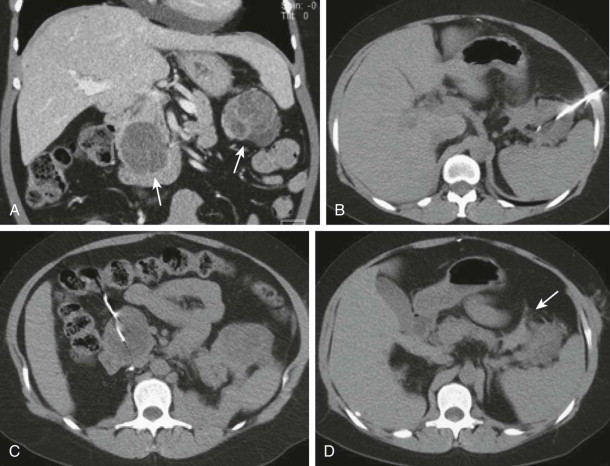
Technical Considerations
Percutaneous biopsy of pancreatic masses is now most often guided by ultrasound, CT, and, rarely, MRI. To our knowledge, there are no data to support use of one modality for all masses. Ultrasound is widely available, multiplanar, portable, and free of ionizing radiation; it provides real-time imaging and is less expensive than CT or MRI. However, not all pancreatic masses are visible with ultrasound. Because of its posterior location in the anterior pararenal space, the pancreas cannot always be seen in patients with intervening bowel gas or excessive abdominal fat, and it may be difficult to visualize the location of the needle tip. CT can be used to visualize almost all pancreatic masses (although intravenous contrast material may be needed rarely) and is excellent in depicting surrounding normal pancreas, the hypodense/hypovascular tumor, and the needle tip. MRI is typically reserved for the unusual mass that is not visualized well with CT or ultrasound. In general, we recommend using the imaging modality that depicts the mass best and that modality with which the radiologist is most familiar.
Percutaneous biopsy of pancreatic masses can be performed with a wide range of needle sizes. Percutaneous pancreatic mass biopsy refers to a procedure during which imaging is used to guide any needle into a pancreatic mass percutaneously for the purpose of obtaining a tissue diagnosis. This includes biopsies that use fine needles (20 gauge or thinner) or large needles (19 gauge or larger). Some authors distinguish between fine-needle aspirations, during which only fine needles are used and the tissue is examined cytologically, and biopsies, during which large needles are used to procure fragments of tissue, sometimes referred to as cores, which are examined histologically. In general, fine-needle aspiration biopsy specimens are analyzed cytologically, and large-needle biopsy specimens are analyzed histologically. Needles may also differ by type; some are end cutting, others are side cutting.
There are no data to suggest that pancreatic masses are better biopsied with fine needles (20 gauge or thinner) or large needles (19 gauge or larger). Diagnostic sensitivities for percutaneous biopsy procedures using only fine needles vary from 71% to 94.7%. The reason for this range of diagnostic sensitivity might be that some studies included cystic and solid pancreatic masses, whereas others focused on solid pancreatic masses only. As mentioned before, the diagnostic work-up of most cystic pancreatic masses involves analysis of cystic fluid for biochemical and tumor markers rather than tissue sampling; thus, the accuracy of fine-needle aspiration biopsy is related to both the ability to position a needle in a mass and the accuracy of the biochemical analysis of the cystic fluid.
Biopsies performed with large (typically 18 gauge) needles have yielded similar sensitivities. These series showed that sensitivities for detection of malignant neoplasms range from 69% to 93%. Therefore, although there has been no statistically valid comparison study for any definitive conclusions to be drawn, on the basis of current available data, it is reasonable to conclude that fine needles are adequate by themselves to biopsy the majority of pancreatic masses. Although use of large needles may increase accuracy in selected circumstances, we believe that they increase the risk of complications, particularly bleeding and pancreatitis. Therefore, in our practice, we begin with fine needles and ask our cytologists to examine one or two specimens intraprocedurally. If the preliminary cytology impression is that the specimen is adequate, the procedure is completed with fine needles alone. If there is any question as to the specimen’s adequacy, we obtain large-needle specimens for histologic analysis.
The pancreas is located in the anterior pararenal space, and access routes that avoid traversal of liver, stomach, colon, small bowel, spleen, or kidney are preferentially selected to minimize the risk of bacterial contamination and hemorrhage. If possible, an approach avoiding traversal of normal pancreatic tissue is also preferred to minimize the risk of pancreatitis. Anterior routes through the liver or stomach can be used if no other routes are available. Transgressing the stomach theoretically increases the risk of infection in patients who are receiving H1 receptor blockers or any other medications that raise gastric pH because the gastric fluid is not sterile. Moreover, percutaneous biopsy of cystic pancreatic lesions by a transgastric route may impair the diagnostic accuracy of the biopsy because gastric mucin-producing cells may contaminate the smear.
Diagnostic Effectiveness
Several studies have evaluated the sensitivity, specificity, and overall accuracy of biopsy of pancreatic masses. These studies vary considerably with respect to patient population, tumor type, guidance modalities, and needle size. Overall, the sensitivity of biopsy for diagnosis of malignant disease is 71% to 97% regardless of needle size used or whether the specimens were examined by cytology, histology, or both. False-negative results are most often due to failure to place the needle tip accurately in a small mass or to sampling of coexistent desmoplastic reaction or pancreatitis adjacent to the mass. Even in experienced hands, false negatives do occur, suggesting that negative results should be viewed with caution in patients with a radiologically suspicious mass.
Tillou and associates reported a diagnostic rate of 96.5% for diagnosis of pancreatic masses by CT- and transabdominal ultrasound–guided fine-needle aspiration biopsy. In a retrospective study, Qian and Hecht showed that CT-guided biopsies had sensitivity of 71%. In the study by Mallery and coworkers, CT- and transabdominal ultrasound–guided pancreatic biopsies (80%) had a higher sensitivity than endoscopic sonography–guided biopsies (74%). In one study, we also found higher sensitivity for CT guidance (94.9%) compared with endoscopic sonographic guidance (85%). However, the difference did not reach statistical significance. In the study of Qian and Hecht, the negative predictive values of CT- and endoscopic sonography–guided fine-needle aspiration biopsies were similar, 41% and 45%, respectively. Mallery and coworkers reported negative predictive values of 23% and 27% for fine-needle aspiration biopsies performed under CT and endoscopic sonographic guidance, respectively. We found negative predictive values of 60% and 57.1% for CT- and endoscopic sonography–guided fine-needle aspiration biopsy, respectively. Also in our study, the frequency of small masses biopsied under endoscopic sonographic guidance (81.5%) was significantly higher than the frequency of those biopsied under CT guidance (32.6%). In fact, since the first report of the use of endoscopic sonography–guided fine-needle aspiration biopsy for the diagnosis of pancreatic cancer in 1994, it has been reported that endoscopic sonography–guided fine-needle aspiration biopsy is more accurate than CT-guided fine-needle aspiration biopsy, especially for small pancreatic masses. To evaluate the effect of mass size on biopsy performance, we stratified results by mass size. There were no significant differences in test characteristics between the guidance groups after the data were stratified by mass size; small masses were not more effectively biopsied under endoscopic sonography guidance.
Because cytology is a relatively insensitive test in the diagnosis of cystic pancreatic neoplasms, advances in cyst fluid tumor markers analysis, immunohistochemistry, and molecular techniques have been used to improve the sensitivity for detection of malignant changes in these lesions. Cyst fluid carcinoembryonic antigen (CEA) values are uniformly low in serous pancreatic adenomas, higher in mucinous lesions, and markedly elevated in mucinous cystadenocarcinomas. A pooled analysis of 12 studies in 450 patients on the role of cyst fluid analysis in the differential diagnosis of pancreatic cystic lesions showed that a CEA level greater than 800 ng/mL is strongly suggestive of a mucinous tumor. Other studies confirmed that of all tested markers (e.g., amylase, mucicarmine staining, carbohydrate antigen 19-9), cyst fluid CEA is the most accurate test available for the diagnosis of mucinous cystic lesions of the pancreas. Finally, studies have revealed specific roles of molecular analysis of clusterin-β and MUC4 to help distinguish reactive ductal epithelial cells from the cells of pancreatic adenocarcinoma in fine-needle aspiration samples, of mutational analysis for K- ras point mutations and loss of heterozygosity in differentiating benign from malignant cystic neoplasms, and of immunohistochemical staining for MUC1 overexpression as a specific marker of invasive carcinoma in intraductal papillary mucinous neoplasm.
Complications
Percutaneous pancreatic mass biopsy is a safe procedure, and reported complication rates are low for both CT-guided and sonography-guided fine-needle aspiration biopsy of the pancreas. In a meta-analysis, Chen and associates reported a complication rate of 4% for CT-guided procedures. Bleeding is the most frequent complication, but it is usually subclinical, detected only with a postprocedural CT scan, and self-limited because of the retroperitoneal location of the pancreas. Although there are no direct comparison data, we believe that peripancreatic hemorrhage is more likely with large needles.
The second most common complication is acute pancreatitis due to inadvertent transgression or biopsy of normal pancreatic parenchyma. It is almost always self-limited but may be prolonged because of pancreatic ductal disruption.
Seeding of the needle track with tumor is a theoretical consequence of percutaneous biopsy of a malignant pancreatic mass, but it is extremely rare and therefore should not be a deterrent to biopsy when there is an appropriate indication. To our knowledge, only one case of needle track seeding associated with pancreatic mass biopsies has been reported.
Role of Interventional Radiology in the Management of Acute Necrotizing Pancreatitis
Background
The International Symposium on Acute Pancreatitis held in 1992 in Atlanta defined acute pancreatitis as inflammation of the pancreas with variable secondary involvement of remote organs. Acute necrotizing pancreatitis is a severe form of the disease associated with significant morbidity and mortality. Percutaneous image-guided catheter drainage is an important treatment option that can be lifesaving when it is used alone or as an adjunct to surgery. Successful treatment outcomes depend on close cooperation and teamwork among gastroenterologists, surgeons, and interventional radiologists.
Pancreatic necrosis is defined as a diffuse or focal area of nonviable pancreatic tissue. Infection of the necrotic portion of the pancreas results in infected necrosis. Infected pancreatic necrosis is an “intermediate” complication of acute pancreatitis, usually occurring between the third and eighth weeks after onset of symptoms. Infected necrosis and sterile necrosis both carry a high mortality rate. Mortality rates of 30% to 35% have been reported in patients with infected necrosis and 10% to 15% in patients with sterile necrosis. Although the presence of infection increases the mortality rate in patients with pancreatic necrosis, a review of 1110 cases of acute pancreatitis demonstrated that mortality is more strongly linked to the presence of organ failure than to the presence of infection itself.
Although no universally accepted treatment algorithm exists, a general consensus of indications for the interventional approach to patients with acute pancreatitis has been described. Some percutaneous drainage procedures are performed to stabilize the seriously ill patient before surgical débridement, whereas others are done with the intent to cure. In some cases, percutaneous drainage follows surgical therapy that has been only partially successful. Treatment algorithms vary among medical centers and are sometimes based on expertise of both the interventional radiologist and the surgeon. The clinical status of the patient, for instance, the presence of sepsis, also influences which approach is best in any given clinical situation.
Image-Guided Catheter Drainage: Technique
Access Route
Most pancreatic fluid collections are located in the lesser sac, the anterior pararenal space, or other parts of the retroperitoneum. Access routes that avoid traversal of colon, small bowel, stomach, spleen, and kidney are preferred to minimize the risk of bacterial contamination and hemorrhage. If possible, a retroperitoneal approach through the lateral flank is chosen over an anterior approach through the peritoneum. Some authors suggest that anterior routes involve the theoretical disadvantage of antigravity flow of fluid through the catheter. Anterior routes through the liver or stomach can be used if no other routes are available. Transgressing the liver theoretically increases the risk of bleeding but in practice is generally safe. Transgressing the stomach is also safe, but peristalsis in the stomach may result in catheter dislodgment several days after its placement. Moreover, caution should be taken in patients who are receiving H1 receptor blockers or any other medications that raise gastric pH because the gastric fluid may not be sterile. Fluid collections involving the pancreatic tail can be drained through the left anterior pararenal space, avoiding the descending colon posteriorly. Similarly, pancreatic head collections can be drained through the right anterior pararenal space. Typically, the patient’s position on the interventional CT table should be adjusted to a slight posterior oblique position to optimize access to the region of interest.
Catheter Selection and Placement
The fluid contained in collections caused by pancreatic necrosis is often viscous. Therefore, adequate drainage of pancreatic and peripancreatic collections typically requires catheters with multiple side holes and a minimum diameter of 12F to 14F. Multiple catheters may be required to drain large or multiloculated necrotic collections. If the fluid is not viscous, 12F to 14F drainage catheters may be satisfactory. Either the tandem trocar technique or Seldinger technique can be used, depending on the operator’s experience. If the Seldinger technique is used, the catheter track should be sequentially dilated over a guidewire. If the necrotic material is viscous and the collection is not drained completely, catheters larger than 14F may be exchanged several days after a 14F catheter is placed initially. An attempt should be made to place as much length of the catheter containing side holes as possible transversely into the necrotic pancreatic collection from the lateral flank approach to maximize drainage.
Management of Sterile Pancreatic Necrosis
In general, in patients with sterile pancreatic necrosis, CT scans of the abdomen are repeated every 7 to 10 days to follow the evolution of pancreatic necrosis and to look for complications. Patients who persistently show clinical instability with tachycardia, fever, leukocytosis, or organ failure may require image-guided percutaneous needle sampling to evaluate for infected pancreatic necrosis. It is important that the access route avoid small and large bowel so as not to contaminate the collection or the aspiration sample ( Fig. 95-5 ).

